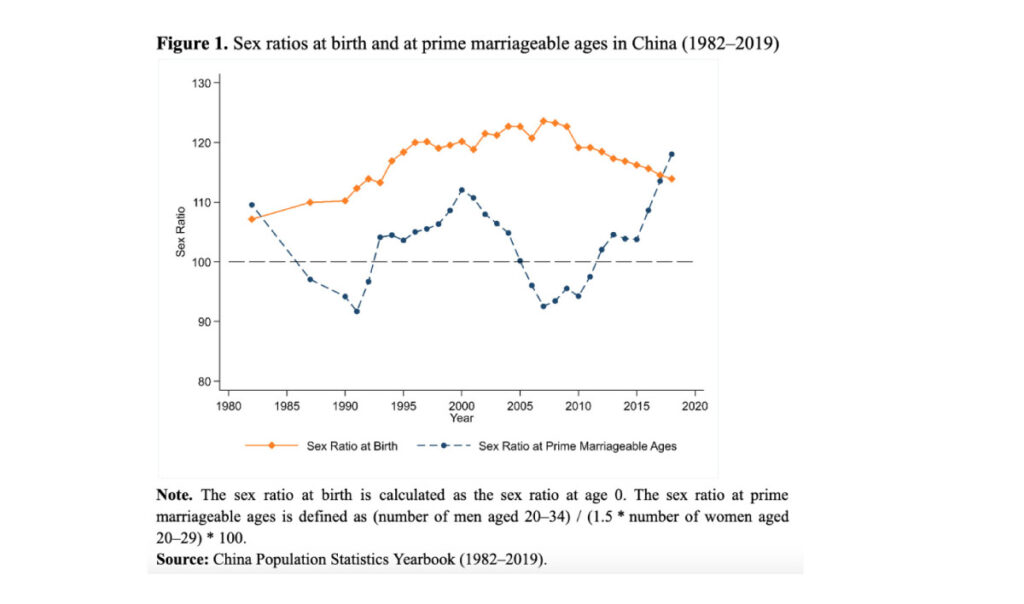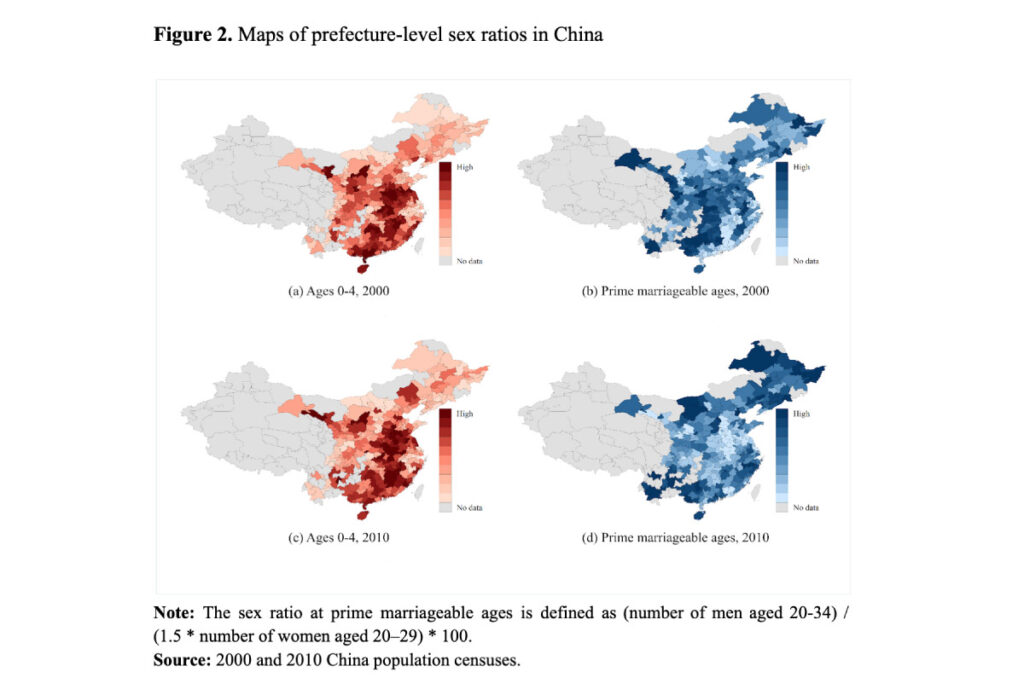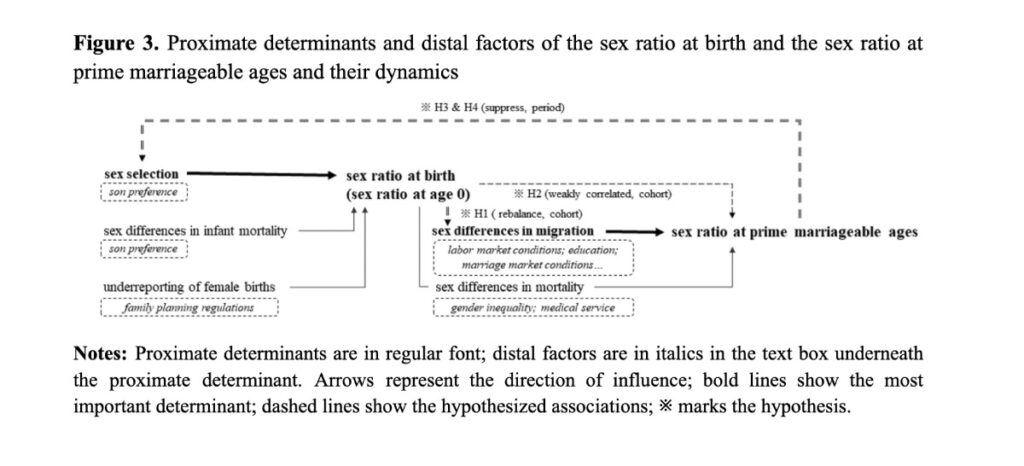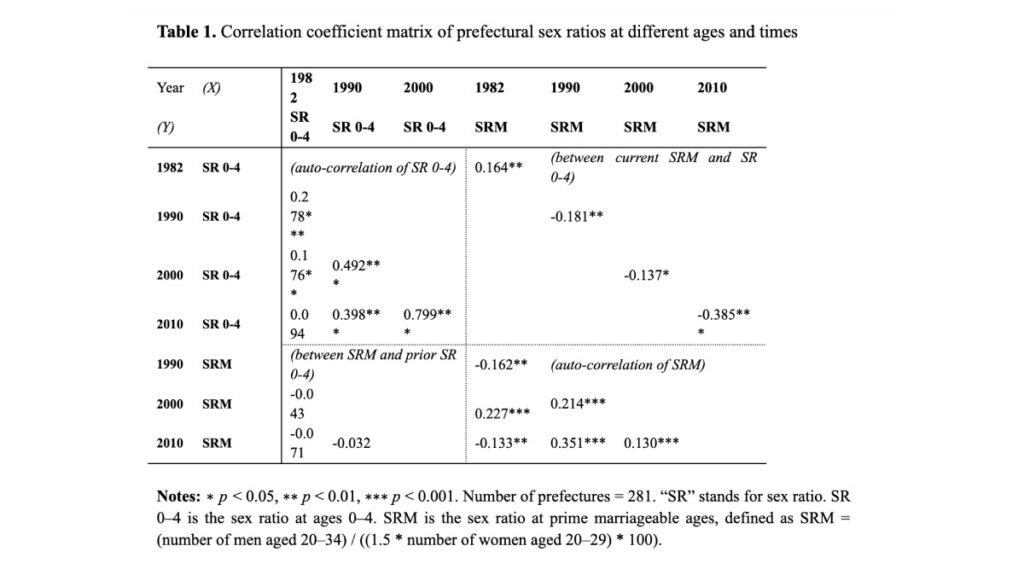Through a detailed analysis of the dynamics of regional sex ratios at birth and, separately, at prime marriageable ages in China, Wanru Xiong finds that regional sex ratios tend to self-correct, and to revert to their “natural” values by inducing responsive behaviours in internal migration and sex selection at birth.
Sex imbalance is a big problem in China. At birth, the “natural” sex ratio is about 103–107 males per 100 females, but it is higher in China: above 110 in the mid-1980s and up to 120 in the late 2000s (Figure 1). Consequently, in 2020 men outnumbered women by 17.5 million among people aged 20–39 (National Bureau of Statistics of China, 2021).

The imbalance results from the combination of son preference entrenched in the traditional patriarchal culture and the family planning (one-child) policy introduced in the early 1980s, which restricted the number of births per couple. This imbalance leads to intense competition among men for brides, as reflected by soaring “bride prices” (betrothal gifts, from the groom’s to the bride’s family) and, possibly, greater bargaining power of women within couples. It may also be a factor in certain social problems such as violence (Cameron, Meng, and Zhang, 2019) and high-risk sexual activities (Tucker et al. 2019). One feature of the sex ratio imbalance is the time gap of around twenty years between its causes (when the cohort is born) and its major consequences (when the cohort enters marriageable ages). It is therefore opportune to differentiate between the sex ratio at birth (SRB) and the sex ratio at prime marriageable ages (SRM). As Figure 1 shows, the national SRB and the SRM have moved in the opposite directions since 2000.
Two sex ratios
At national level, the SRB and SRM of a given cohort are similar, with slight differences due to differential mortality and net international migration. However, at the regional level, they can be significantly different because young men and women move between regions. Of course, the two sex ratios can also differ at any given time due to cohort differences.
Figure 2 shows the maps of prefecture-level sex ratios at ages 0–4 (SR 0–4, a proxy for SRB) and SRMs according to the 2000 and 2010 Chinese censuses in prefectures with a majority of Han Chinese residents. Higher SRs 0–4 are consistently observed in the southern coastal areas and the inner central areas, whereas the regional distribution of SRMs is different, with higher values appearing in the southwest, northwest, northern, and part of the eastern coastal areas.

Self-corrective mechanism
In a recent study, I proposed a self-corrective mechanism to model the dynamics between regional SRBs and SRMs in China (Xiong, 2022). The mechanism consists of two pathways:
• First, internal migration redistributes men and women across regions in a way that reduces highly skewed regional SRMs;
• Second, a competitive marriage market for men reduces parental incentives for son-biased sex selection, thus lowering regional SRBs.
Figure 3 shows the diagram of the mechanism. As the bold lines indicate, the most important direct determinant of SRB and SRM are prenatal sex selection and internal migration, respectively. The key to the mechanism is the connection between each sex ratio and the main determinant of its counterpart (dashed lines): high SRBs induce internal migration while high SRMs remove incentives for parental sex selection. The two links constitute a negative feedback loop that corrects the regional sex ratios. In other words, the consequences of one high regional sex ratio become the causes of changes in the other sex ratio.

If the proposed self-corrective mechanism is working, the following consequences should be observed:
• H1. Regions with higher SRBs experience greater declines in sex ratios of residents from birth to prime marriageable ages as the cohort ages and migrates.
• H2. Regional SRMs and SRBs 20 years before are weakly correlated.
• H3. Regional SRBs are negatively correlated with contemporary regional SRMs.
• H4. Changes in regional SRBs are negatively correlated with changes in regional SRMs over the same period.
Empirical evidence
There is some evidence for the self-corrective mechanism outlined above. Table 1 shows the association coefficients between the SR 0–4 and the SRM of a cohort or in a given year. The lower left panel supports H2, in that there is no significant linear relationship between SRs 0–4 and SRMs in the same prefecture after about 20 years. The upper right panel shows a significant negative correlation between contemporary SRs 0–4 and SRMs in the same prefecture except in 1982, which supports H3.

More advanced analysis shows that prefectures with higher SRBs in 1982 and 1990 experienced a greater decline in sex ratios of residents when the birth cohort reached marriageable ages in 2000 and 2010 respectively, resulting in a weak correlation between SRBs and subsequent SRMs in the same prefecture. Prefectural SRBs in 2000 and 2010 were negatively correlated with contemporary SRMs: a one-unit higher prefectural SRM was associated with an approximately 0.3-unit lower SRB in 2000 and 0.2-unit lower SRB in 2010. Changes in prefectural SRBs between 1990 and 2010 are negatively correlated with changes in SRMs during the same period.
Conclusion
We find some evidence for the two conjectured self-corrective forces of regional sex ratios. First, internal migration from birth to marriageable ages helps to redress the prefectural sex ratios and achieve a more balanced distribution of SRMs than SRBs. Second, the shortage of women in the local marriage market removes incentives for parental son-biased sex selection and thus lowers SRBs. Prefectures with higher SRBs continue to have relatively higher SRBs than other places; this happens in part because son preference persists over time and in part because these prefectures do not necessarily experience the negative consequences of skewed SRMs. The two forces work together to generate a slow but smooth transition of SRBs toward the natural level in the total population.
The self-corrective mechanism connects the macro demographic context with the micro intentions of migration and sex selection, generating a feedback that helps to correct sex-ratio imbalances. The suggested mechanism emphasizes the presence of endogenous correcting forces within the population system which function independently of the exogenous changes in cultural and socioeconomic contexts that also influence the SRB, such as increasing educational and employment opportunities for women (Guilmoto, 2009). In other words, a population is a complex system, capable of self-regulation. Both endogenous and exogenous forces lead to the prediction that the trajectory of the SRB will continue to converge towards normal levels in China, as it has done since 2010 (Figure 1).
References
Cameron, Lisa, Xin Meng, and Dandan Zhang. 2019. “China’s sex ratio and crime: Behavioural change or financial necessity?.” The Economic Journal 129(618): 790-820.National Bureau of Statistics of China. 2021. “National data.” Beijing: National Bureau of Statistics of China. http://data.stats.gov.cn/index.htm.
Guilmoto, Christophe Z. 2009. “The sex ratio transition in Asia,” Population and Development Review 35(3): 519–549.
Tucker, Joseph, Dudley L. Poston Jr, Qiang Ren, Baochang Gu, Xiaoying Zheng, Stephanie Wang, and Chris Russell, eds. 2009. Gender policy and HIV in China: catalyzing policy change. Vol. 22. Springer Science & Business Media.
Xiong, Wanru. “Dynamics between Regional Sex Ratios at Birth and Sex Ratios at Prime Marriageable Ages in China.” Population and Development Review.


